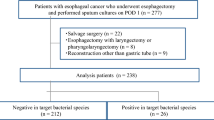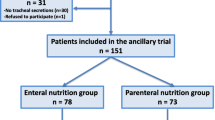Abstract
Background
Surgical complications occur frequently after radical esophagectomy and one of its most serious complications is postoperative pneumonia. Preoperative or postoperative bacteriological assessment may be useful in predicting, preventing, and managing postoperative pneumonia.
Methods
One hundred and five consecutive patients undergoing any procedure that included subtotal esophagectomy from October 2009 to March 2011 were the subject of this study. Culture materials (pharyngeal swab, nasal swab, dental plaque, tongue coating, gastric juice, and sputum) retrieved from the 105 esophageal cancer patients before, during, and after the surgery were comprehensively investigated for an association with postoperative pneumonia.
Results
Twenty-one patients out of 105 (20%) were retrospectively diagnosed with postoperative pneumonia. The investigated culture studies were associated with the occurrence of postoperative pneumonia in only one respect: positive detection of pathogens in postoperative endotracheal sputum was associated with marginally increased pneumonia (P = 0.053). Among the 21 pneumonia patients, pathogens were frequently detected in gastric juice retrieved on the first postoperative day (8 out of 14) and postoperative endotracheal sputum (13 out of 17). The putative pathogens of postoperative pneumonia were detected in 7 out of 8 gastric juice specimens and 9 out of 11 in sputum.
Conclusions
Postoperative pneumonia could not be predicted by either preoperative or postoperative bacteriological studies. In the patients with postoperative pneumonia, the postoperative bacterial culture of the gastric juice and sputum may be useful in identifying the causative organisms of postoperative pneumonia and, thus, in selecting appropriate antibiotics.
Similar content being viewed by others
References
Shiozaki A, Fujiwara H, Okamura H, et al. Risk factors for postoperative respiratory complications following esophageal cancer resection. Oncol Lett. 2012;3(4):907–12.
Luketich JD, Schauer PR, Christie NA, et al. Minimally invasive esophagectomy. Ann Thorac Surg. 2000;70(3):906–11.
Watanabe M, Mine S, Nishida K, et al. Improvement in short-term outcomes after esophagectomy with a multidisciplinary perioperative care team. Esophagus. 2016;13(4):337–42.
Law S, Wong KH, Kwok KF, et al. Predictive factors for postoperative pulmonary complications and mortality after esophagectomy for cancer. Ann Surg. 2004;240(5):791–800.
Zingg U, Smithers BM, Gotley DC, et al. Factors associated with postoperative pulmonary morbidity after esophagectomy for cancer. Ann Surg Oncol. 2011;18:1460–8.
Bakhos CT, Fabian T, Oyasiji TO, et al. Impact of the surgical technique on pulmonary morbidity after esophagectomy. Ann Thorac Surg. 2012;93(1):221–7.
Ferguson Mark K, Durkin Amy E. Preoperative prediction of the risk of pulmonary complications after esophagectomy for cancer. J Thorac Cardiovasc Surg. 2002;123(4):661–9.
Hsu PK, Huang CS, Wu YC, et al. Open versus thoracoscopic esophagectomy in patients with esophageal squamous cell carcinoma. World J Surg. 2014;38(2):402–9.
Yoshida N, Watanabe M, Baba Y, et al. Risk factors for pulmonary complications after esophagectomy for esophageal cancer. Surg Today. 2014;44(3):526–32.
Molena D, Mungo B, Stem M, et al. Incidence and risk factors for respiratory complications in patients undergoing esophagectomy for malignancy: a NSQIP analysis. Semin Thorac Cardiovasc Surg. 2014;26(4):287–94.
Sumi Y, Miura H, Michiwaki Y, et al. Colonization of dental plaque by respiratory pathogens in dependent elderly. Arch Gerontol Geriatr. 2007;44(2):119–24.
Akutsu Y, Matsubara H, Okazumi S, et al. Impact of preoperative dental plaque culture for predicting postoperative pneumonia in esophageal cancer patients. Dig Surg. 2008;25(2):93–7.
Akutsu Y, Matsubara H, Shuto K, et al. Pre-operative dental brushing can reduce the risk of postoperative pneumonia in esophageal cancer patients. Surgery. 2010;147(4):497–502.
Ephgrave KS, Kleiman-Wexler R, Pfaller M, et al. Postoperative pneumonia: a prospective study of risk factors and morbidity. Surgery. 1993;114(4):815–21.
Japanese Respiratory Society. Definition of hospital-acquired pneumonia and characteristics of guidelines in Japan. Respirology. 2009;14(2):S1–3.
Author information
Authors and Affiliations
Corresponding author
Ethics declarations
Ethical Statement
All procedures followed were in accordance with the ethical standards of the responsible committee on human experimentation (institutional and national) and with the Helsinki Declaration of 1964 and later versions. Informed consent or substitute for it was obtained from all patients for being included in the study.
Conflict of interest
Keiichi Jimbo, Kazuhiko Mori, Susumu Aikou, Mitsuhiro Okazaki, Tomoaki Sato, Kyoji Moriya, Yoko Kawase-Koga, Yoshiyuki Mori, Yuki Kanno, Yukinori Yamagata, Koichi Yagi, Masato Nishida, Hiroharu Yamashita, Sachiyo Nomura, and Yasuyuki Seto declare that they have no conflict of interest.
Rights and permissions
About this article
Cite this article
Jimbo, K., Mori, K., Aikou, S. et al. Detection and identification of pathogenic bacteria responsible for postoperative pneumonia after esophagectomy. Esophagus 14, 153–158 (2017). https://doi.org/10.1007/s10388-016-0561-5
Received:
Accepted:
Published:
Issue Date:
DOI: https://doi.org/10.1007/s10388-016-0561-5




